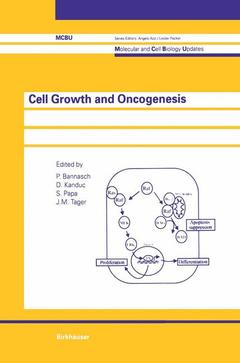Description
Cell Growth and Oncogenesis, 1998
Molecular and Cell Biology Updates Series
Coordinators: Papa S., Kanduc D., Tager J.M.
Language: English
Subject for Cell Growth and Oncogenesis:
312 p.
· 15.5x23.5 cm
· Paperback
Description
/li>Contents
/li>
Rapid progress has been made in our understanding of the molecular mechanisms of cell growth and oncogenesis during the past decade. This book comprises recent results on the regulation of cell growth in normal and neoplastic tissues by growth factors including hormones, and by the activation and inactivation of oncogenes and tumor suppressor genes, respectively. Special attention has been given to the presentation of the frequently neglected close correlation between changes in signal transduction and metabolism pathways during oncogenesis.
Ion homeostasis, energy metabolism and control of cell growth.- Glucose catabolism in cancer cells: Role and regulation of hexokinase overexpression.- Double role of pyruvate kinase type M2 in the regulation of phosphometabolite pools.- The mitochondrial ATP synthase in normal and neoplastic cell growth.- The pH of internal compartments of normal and activated cells.- Signal transduction, oncogenes and growth factors.- Hepatic regeneration: New concepts on cell proliferation.- Raf-dependent signaling pathways in cell growth and differentiation.- E7 protein of human papillomaviruses and its interaction with cellular pathways.- Phosphorylation of the p53 tumour suppressor protein by stress- and DNA damage-activated protein kinases.- Bile acids, cell proliferation and protein phosphorylation.- Alteration of cell division cycle regulation in human cancers: The role of CDKN2A gene.- The bombesin receptor is coupled to multiple signal transduction pathways and induces cell proliferation.- Control of cell proliferation by a-tocopherol.- Development of resistance to the mitoinhibitory effects of orotic acid during experimental liver carcinogenesis.- Mechanisms of carcinogenesis and drug resistance of cancer cells.- Early aberrations of energy metabolism in carcinogenesis.- Stimulation of liver cell growth by direct mitogens.- Low-number intrahepatic islet transplantation — a model of hormonal hepatocarcinogenesis.- Translational regulation: possible significance of differential tRNA expression during the transition from quiescence to proliferation.- Cloning and expression of a stable ornithine decarboxylase form conferring selective growth advantage to the HMOA cells against cytostatic treatment with ?-methylornithine.- Changing the lipid composition in hepatoma cellmembranes can affect cell death and proliferation.- The multidrug resistance phenotype: P-glycoprotein, regulation of the mdr genes and other related mechanisms.
© 2024 LAVOISIER S.A.S.

